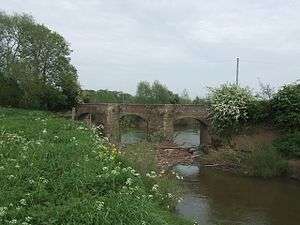Battle of Powick Bridge
| Battle of Powick Bridge | |||||||
|---|---|---|---|---|---|---|---|
| Part of the First English Civil War | |||||||
 | |||||||
| |||||||
| Belligerents | |||||||
| Royalists | Parliamentarians | ||||||
| Commanders and leaders | |||||||
| Prince Rupert of the Rhine | Colonel Nathaniel Fiennes | ||||||
| Strength | |||||||
| 1,000 horse[1] | 1,000 horse[1] | ||||||
| Casualties and losses | |||||||
| negligible[1] | 40 killed, 100 wounded[1] | ||||||
The Battle of Powick Bridge, fought on 23 September 1642, was the first major cavalry engagement of the English Civil War. It was a Royalist victory. According to Hugh Peters it was "where England's sorrows began".[2]
Prelude
King Charles I of England had left London and raised his standard in Nottingham on 22 August 1642. Although some skirmishing had occurred throughout the country, it was on 13 September, that the main campaign of the First English Civil War opened. King Charles, in order to reach the armouries of Derbyshire and Staffordshire, and find recruits amongst his sympathisers and trained bands, and also to be in touch with his disciplined regiments in Ireland by way of Chester, moved westward from Nottingham through Cheshire to Shrewsbury. The Earl of Essex with an army of about 20,000 men followed suit by marching his army from Northampton to Worcester.[3]
Battle
Near Worcester, a sharp cavalry engagement, now known as the Battle of Powick Bridge, took place on 23 September between the advanced cavalry of Essex's army, and a force under Prince Rupert, which was engaged in protecting a small Royalist supply train bringing "plate" donated by the University of Oxford to the King's mint for smelting into coin, and which was sheltering in Worcester.
The "battle" was closer to a skirmish, but nonetheless important. It started almost farcically, the two opposing cavalry units having set up camp in almost adjacent fields, it was only by luck that the Royalists stumbled across the enemy first and did not give the game away.
In the ensuing excitement Rupert showed the leadership that earned him his reputation as an exemplary officer. Instructing his men to mount up and attack before the Parliamentarians could organise themselves, he led his force into the enemy camp, with some of them not having had time to do up their breast plates, their armour flapping as they rode. His men surprised and routed the opposition. Casualties were minimal on both sides but the university silverware had been saved and would serve to bankroll the King for start of the war, while Essex was put on the back foot.
The result of the fight was the immediate overthrow of the Parliamentary cavalry, and this gave the Royalist troopers a confidence in themselves and in their victorious leader, which was not shaken until they met Oliver Cromwell's Ironsides.
Aftermath
Rupert soon withdrew north to Shrewsbury, where he found many Royalist officers eager to attack Essex's new position at Worcester. But the road to London now lay open and it was decided to take it. The intention was not to avoid a battle, for the Royalist generals wanted to fight Essex before he grew too strong, and the temper of both sides made it impossible to postpone the decision. In the Earl of Clarendon's words: "it was considered more counsellable to march towards London, it being morally sure that Essex would put himself in their way". Accordingly, the army left Shrewsbury on 12 October, gaining two days' start on the enemy, and moved south-east. This had the desired effect.[4]
Parliament, alarmed for its own safety, sent repeated orders to Essex to find the King and bring him to battle. Alarm gave way to determination, when it was discovered that Charles was enlisting papists and seeking foreign aid. The militia of the home counties was called out. A second army under Earl of Warwick was formed round the nucleus of the London trained bands, and Essex, straining every nerve to regain touch with the enemy, reached Kineton, where he was only seven miles (eleven kilometres) from the King's headquarters at Edgecote, on 22 October. The inconclusive Battle of Edge Hill was fought the next day.[4]
By coincidence the English Civil Wars ended with another clash at Powick Bridge almost exactly nine years later at the Battle of Worcester on 3 September 1651. The Royalists broke the bridge, but Major-General Richard Deane forced his way over the River Teme and pursued them into Worcester. After the battle the New England preacher Hugh Peters gave the Parliamentarian militia a rousing farewell sermon "when their wives and children should ask them where they had been and what news, they should say they had been at Worcester, where England's sorrows began, and where they were happily ended".[2]
Notes
- 1 2 3 4 BFT staff 2012
- 1 2 Atkin 1998, p. 120.
- ↑ Atkinson 1911, p. 403.
- 1 2 Atkinson 1911, p. 404.
References
- BFT staff (2012). "UK Battlefields Resource Centre - The Civil Wars - The Edgehill Campaign - The Battle of Battle of Powick Bridge". Battlefields Trust.
- Atkin, Malcolm (1998). Cromwell's Crowning Mercy The battle of Worcester 1651. Sutton Publishing. p. 120.
- Attribution
 This article incorporates text from a publication now in the public domain: Atkinson, Charles Francis (1911). "Great Rebellion". In Chisholm, Hugh. Encyclopædia Britannica. 12 (11th ed.). Cambridge University Press. pp. 403, 404.
This article incorporates text from a publication now in the public domain: Atkinson, Charles Francis (1911). "Great Rebellion". In Chisholm, Hugh. Encyclopædia Britannica. 12 (11th ed.). Cambridge University Press. pp. 403, 404.
Further reading
- Battle of Powick Bridge part of The Battlefields Trust Resource Centre of The Battlefields Trust
- 1642: First campaigns of the English Civil War on the British Civil Wars & Commonwealth website
- Powick Bridge website of English Civil War